If you think that the life of an armored man during World War II was all about chasing a dog after redheaded nurses and washing the cannons to sensitive tanks, then we must disappoint you. It was neither that simple nor that pathetic. At least in the British Army.
Reading the memories of British tankers, you can't help but get the impression that these guys they only had one thing in mind:how to get a cup of tea !? They could do it under any circumstances and at any time. It happened that the order to brew tea came top-down by radio, e.g. from the commander of a regiment or a squadron. Typically, a backup driver was assigned to this honorable task, hopping outside and preparing a drink under the cover of the tank, often exposing himself to enemy fire.
British tankers were MacGyver's ancestors?
Mainly gas or spirit cookers were used to brew tea, although the British also used more sophisticated methods. During operations in North Africa, four-gallon (approximately 18 liter) cans filled with gasoline soaked sand were in common use.
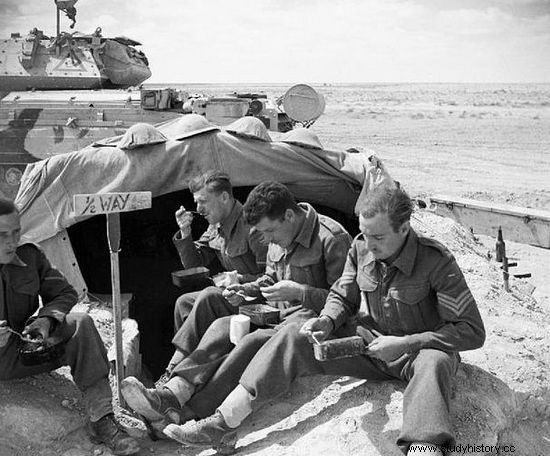
The Crusader crew is eating breakfast next to their tank. They will probably cook their lunch by putting food cans next to the exhaust pipe. North Africa 1942.
A vessel with water was placed in them and set on fire. There were legends among the soldiers of the 8th Army about a tank crew craving tea in the middle of a minefield. The armored personnel set fire to the can inside the car - the effect of this treatment was apparently very spectacular.
When it comes to preparing meals, the British tankers were also extremely inventive. During desert fights, they placed food cans near the exhaust pipes, and this was how dinner was cooked while driving. Regarding the menu, they didn't have much choice.
They disgusted me with meat and canned vegetables, canned peaches and condensed milk. From time to time you would find hideous warm beer "from India", while the higher ranks - from the sergeant up - were given an assigned whiskey.
Poultry houses on caterpillars
Tanks were more than just machines to their crews. These were their homes. On armors, in specially constructed containers and baskets, they carried all the things necessary for life:bedding, sleeping bags, kitchen utensils. Personal belongings were limited to the minimum necessary:toiletries, uniform blouses, trousers, T-shirts and socks for a change. Ammunition usually occupied the most space. Moreover, as he writes in his book "Monte Cassino. Hell of Ten Armies ”Peter Caddick-Adams:
Tank crews in Italy discovered that wine bottles fit perfectly with the ammunition racks, and some crews mentioned that in Cassino turrets kept live hens ensuring the delivery of fresh eggs .
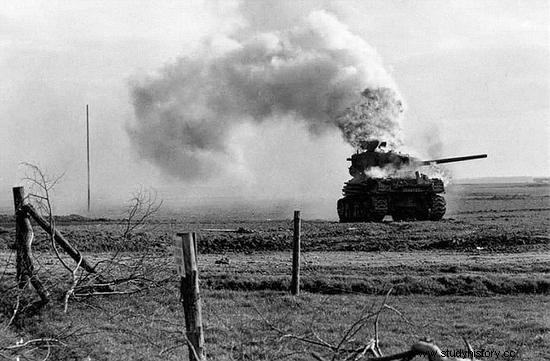
Shermans were widely used in Allied armored units. Unfortunately, they had many disadvantages, one of the most serious was frequent fire. That is why the Germans called them "Britol's cookers", while the Islanders themselves called them Ronsons (a brand of reliable lighters).
Working conditions in the tanks of that time left much to be desired. You could forget about amenities such as heating and air conditioning. White painted tank interiors boiled during summer and were icy during Apennine winters .
During the fight, a great problem was the proper ventilation of the interior of the car, as a result of which the crew was forced to breathe a mixture of air, dust and gunpowder gases. Thus, it was common to see tanks firing with open hatches of turrets, from which an umbrella could stick out in bad weather!
Stove for Britola cooking
The main tank type in the Royal Armored Corps has been the M4 Sherman since the Battle of El Alamein. Its crew consisted of 5 people:the commander, gunner and loader were in the turret, while the driver and his assistant (the one who made tea, who is also a machine gunner) were in the lower front part of the hull.
In the event of a hit by an enemy missile, it was the latter two who had the least chance of survival. They could evacuate through the hatches above their heads, but these were usually blocked by the main gun barrel. There were two more escape routes:either through a small hatch in the floor or through the tower. In practice, however, it was taking too long. Death in the flames was so solid, the more so that the fire extinguisher could only be used to extinguish an overheated engine .
It was this "flammability" that was Sherman's greatest flaw. It was not without reason the Germans called these American tanks "Britons' cookers" and the British - with their own sarcasm - the Ronsons, from a brand of reliable lighters that fired every time.
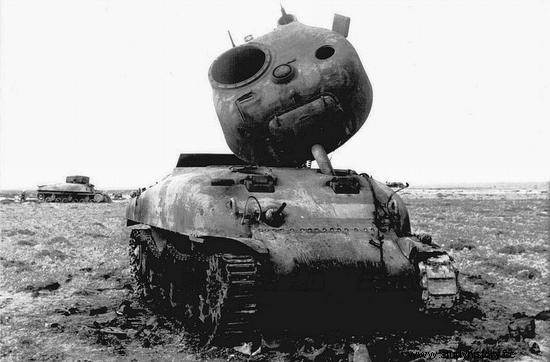
Contrary to popular belief circulating among infantrymen, the cause of the Shermans' frequent explosions after a direct hit was not the gasoline engine, but the ammunition stored in the turret.
Hit Shermans often exploded in a spectacular way, losing the turret which was broken by the explosion. However, contrary to popular belief, widespread among infantrymen, it was not the gasoline engine that caused it, but the ammunition stored in the turret. Nevertheless, one must agree with what one infantry soldier said - quoted by Peter Caddick-Adams: I thanked the good God that I was not a tanker .
This article has more than one page. Please select another one below to continue reading.Attention! You are not on the first page of the article. If you want to read from the beginning click here.
Just a pile for the Tiger, gentlemen
And how did Sherman fare against German tanks? Unfortunately, not only for British, but also Polish, Canadian, French and American tankers - terrible. While he was an equal opponent for the German Panzer III and Panzer IV tanks, he had a poor chance of winning in direct clashes with the Panther or the Tiger.
There were many disadvantages:its tall, three-meter silhouette, too weak cannon, thin armor, narrow tracks and this unfortunate gasoline engine. There was a known case when a German Tiger destroyed two Shermans with one missile !! Just by firing a shot at one tank, he crashed the other at the same time. Another time commanded by Michael Wittmann he single-handedly demolished the entire English Armored Regiment .
In order to try to destroy a German steel monster like the Tiger, at least two conditions had to be met. First, the Shermans must have been outnumbered. Second:you had to get him from the rear. It was definitely not an easy thing to do. After all, the boys from the Panzerwaffe magpie did not fall out from under the tail and knew the weaknesses of their cars.
The value of Sherman in such a duel is well illustrated by the incident that happened to one tanker of General Patton's 3rd Army. From less than thirty yards, he fired three missiles at the Tiger. All of them bounced without causing any damage to the German machine. Nat Frankel recalled:
Then I saw a German officer stick his head out of the tower and smile at me! Then he pulled a white handkerchief from his pocket and wiped the side of the tower where my projectiles bounced off. He smiled again, as if forgiving me for scratching his machine, and put the handkerchief in his pocket.
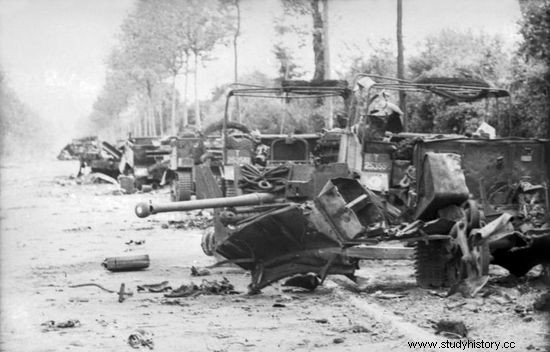
Here are the effects of Michael Wittmann's attack on June 13, 1944 on the 4th Armored Regiment of the County of London Yeomanry. Wittmann could do such damage only because the British tanks could not do anything to him. (source:Bundesarchiv; photo:Arthur Grimm; lic. CC-BY-SA).
The "Ronsons" suffered terrible losses during the war. An example is the US 3rd Panzer Division. By the time she landed in Normandy, she had 232 Shermans in stock. During the war, it lost irretrievably 648 tanks, and another 700 damaged machines were returned to service. As easy to calculate, the total losses until the surrender of Germany amounted to 580%!
It was, of course, also associated with enormous losses in people. Especially after the Battle of the Ardennes, the situation grew so bad that 3-man crews were the norm. There were simply not enough people to complete the full cast. It even got to the point that, for fear of morale, it was forbidden to retrieve the corpses of fallen tankers from the burned machines!
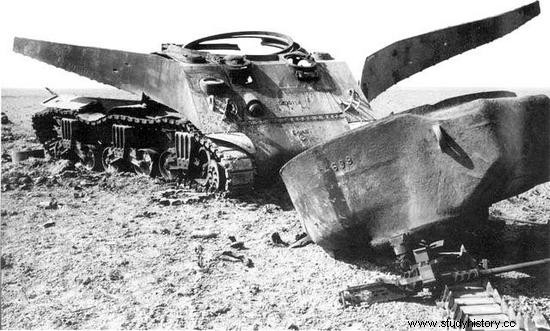
During the fights with Germany, the units in which the "Ronsons" were used suffered huge losses. For example, in the US 3rd Panzer Division it was 580% of the starting figure.
The Allies won the war against Germany, but did their tanks, and the Shermans in particular, help them? Very doubtful. US veteran Belton Cooper stated that: not only contributed to the terrible loss of personnel and equipment, but also delayed the end of the war in Europe. They were definitely better suited for henhouses.
Editing:Krzysztof Chaba; Photo edition:Rafał Kuzak
